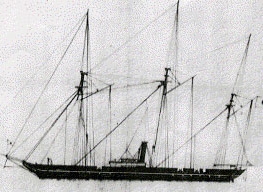Japanese warship Banryū

| |
| History | |
|---|---|
| Name | Banryū (ex Emperor) |
| Ordered | 1856 |
| Builder | R & H Green of Blackwall |
| Laid down | 1856 |
| Launched | 1856 |
| Commissioned | 1857 |
| Decommissioned | 1888 |
| Fate | Broken up late 1890s |
| General characteristics | |
| Displacement | 370 long tons (376 t) |
| Length | 41.8 m (137 ft 2 in) |
| Beam | 5.45 m (17 ft 11 in) |
| Draught | 3.23 m (10 ft 7 in) |
| Propulsion | Steam engine |
| Sail plan | Schooner |
| Armament | 6 × 12-pounder cannon |
Banryū (蟠龍, Coiled Dragon) was a ship of the Tokugawa Navy, and following the collapse of the shogunate, was operated by Tokugawa loyalists under the Republic of Ezo during the Boshin War in Japan. An armed iron hulled screw-propelled schooner, she had a length of 41.8 metres, a breadth of 5.45 metres, a draught of 3.23 metres, and weighed 370 tons. She was armed with four 12-pounder bronze cannons.[1]
Built by R&H Green at the Blackwall Yard as HMY Emperor, she was presented to the Tokugawa administration by James Bruce, 8th Earl of Elgin as a present for the "Emperor" from Queen Victoria on the 26 August 1858, to commemorate the signing of the Anglo-Japanese Treaty of Amity and Commerce. Intended to serve as a royal yacht, its interior was luxuriously furnished with sculptures and mirrors.[2][3]
During the
Under the command of
She was salvaged by an Englishman, and after repairs and rebuilding in
References
- ^ a b King, Ian. "HMS Emperor (1857) (1st) Iron Screw Yacht". Britain's Navy. Retrieved 11 October 2021.
- ISBN 9780275027216.
- ^ "Presentation of HMY 'Emperor' to the Emperor of Japan at Yeddo". Royal Museums Greenwich. National Maritime Museum, Greenwich, London.
- ^ Kublin, Hyman (April 1953). "Admiral Enomoto And The Imperial Restoration". Proceedings. 79 (602). U.S. Naval Institute.
- ISBN 978-0804708159.
- ISBN 9781135786199.
- Eugène Collache, Une aventure au Japon, in "Le Tour du Monde" No.77, 1874.
External links
 Media related to Banryū (ship, 1856) at Wikimedia Commons
Media related to Banryū (ship, 1856) at Wikimedia Commons
